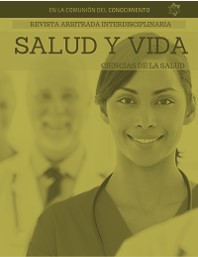Excessive use of alcohol gel as a preventive measure in COVID-19 among college students
DOI:
https://doi.org/10.35381/s.v.v6i2.2151Keywords:
Epidemiology, nursing, chemically induced. (Source, DeCS).Abstract
Objective: To determine the consequences of the excessive use of alcohol, alcohol gel as a preventive measure by covid-19 in the first level of nursing parallel "A" of the university "Uniandes". Method: Descriptive observational. Results: 14.8% of the population stated that their skin is irritated when alcohol is placed on their hands, 3.7% stated that their skin is almost always irritated, 29.6% stated that their skin is sometimes irritated and 51.9% stated that their skin is never irritated. Conclusion: The consequences of the excessive use of alcohol, alcohol gel since the state of alarm caused by COVID-19 was decreed in the population under study, proving that the main symptoms are redness, peeling, dryness, irritation, itching, pain and in some cases even cracks and erosions that can cause bleeding and the appearance of scabs.
Downloads
References
Ferraguti G, Pascale E, Lucarelli M. Alcohol addiction: a molecular biology perspective. Curr Med Chem. 2015;22(6):670-84. doi: 10.2174/0929867321666141229103158. PMID: 25544474.
van de Wiel A. Diabetes mellitus and alcohol. Diabetes Metab Res Rev. 2004 Jul-Aug;20(4):263-7. doi: 10.1002/dmrr.492. PMID: 15250029.
Thakkar MM, Sharma R, Sahota P. Alcohol disrupts sleep homeostasis. Alcohol. 2015 Jun;49(4):299-310. doi: 10.1016/j.alcohol.2014.07.019. Epub 2014 Nov 11. PMID: 25499829; PMCID: PMC4427543.
Engen PA, Green SJ, Voigt RM, Forsyth CB, Keshavarzian A. The Gastrointestinal Microbiome: Alcohol Effects on the Composition of Intestinal Microbiota. Alcohol Res. 2015;37(2):223-36. PMID: 26695747; PMCID: PMC4590619.
de la Monte SM, Kril JJ. Human alcohol-related neuropathology. Acta Neuropathol. 2014 Jan;127(1):71-90. doi: 10.1007/s00401-013-1233-3. Epub 2013 Dec 27. PMID: 24370929; PMCID: PMC4532397.
Engler PA, Ramsey SE, Smith RJ. Alcohol use of diabetes patients: the need for assessment and intervention. Acta Diabetol. 2013 Apr;50(2):93-9. doi: 10.1007/s00592-010-0200-x. Epub 2010 Jun 8. PMID: 20532803; PMCID: PMC2954251.
Kudsiova L, Lansley A, Scutt G, Allen M, Bowler L, Williams S, Lippett S, Stafford S, Tarzi M, Cross M, Okorie M. Stability testing of the Pfizer-BioNTech BNT162b2 COVID-19 vaccine: a translational study in UK vaccination centres. BMJ Open Sci. 2021 Sep 12;5(1):e100203. doi: 10.1136/bmjos-2021-100203. PMID: 35047705; PMCID: PMC8647588.
Zhang M, Feng C, Zhang X, Hu S, Zhang Y, Min M, Liu B, Ying X, Liu Y. Susceptibility Factors of Stomach for SARS-CoV-2 and Treatment Implication of Mucosal Protective Agent in COVID-19. Front Med (Lausanne). 2021 Jan 14;7:597967. doi: 10.3389/fmed.2020.597967. PMID: 33521016; PMCID: PMC7840564.
Carissimo G, Ng LFP. A promiscuous interaction of SARS-CoV-2 with bacterial products. J Mol Cell Biol. 2020 Nov 18;12(12):914-915. doi: 10.1093/jmcb/mjaa068. PMID: 33326034; PMCID: PMC7798951.
Petruk G, Puthia M, Petrlova J, Samsudin F, Strömdahl AC, Cerps S, Uller L, Kjellström S, Bond PJ, Schmidtchen AA. SARS-CoV-2 spike protein binds to bacterial lipopolysaccharide and boosts proinflammatory activity. J Mol Cell Biol. 2020 Oct 12;12(12):916-932. doi: 10.1093/jmcb/mjaa067. PMID: 33295606; PMCID: PMC7799037.
Matsuno H, Yudoh K, Hashimoto M, Himeda Y, Miyoshi T, Yoshida K, Kano S. Antibiotic-containing hyaluronic acid gel as an antibacterial carrier: Usefulness of sponge and film-formed HA gel in deep infection. J Orthop Res. 2006 Mar;24(3):321-6. doi: 10.1002/jor.20070. PMID: 16479564.
Pérez-Köhler B, Benito-Martínez S, Rodríguez M, García-Moreno F, Pascual G, Bellón JM. Experimental study on the use of a chlorhexidine-loaded carboxymethylcellulose gel as antibacterial coating for hernia repair meshes. Hernia. 2019 Aug;23(4):789-800. doi: 10.1007/s10029-019-01917-9. Epub 2019 Feb 26. PMID: 30806886.
Bo Y, Zhang L, Wang Z, Shen J, Zhou Z, Yang Y, Wang Y, Qin J, He Y. Antibacterial Hydrogel with Self-Healing Property for Wound-Healing Applications. ACS Biomater Sci Eng. 2021 Nov 8;7(11):5135-5143. doi: 10.1021/acsbiomaterials.1c00719. Epub 2021 Oct 11. PMID: 34634909.
Soule LD, Pajares Chomorro N, Chuong K, Mellott N, Hammer N, Hankenson KD, Chatzistavrou X. Sol-Gel-Derived Bioactive and Antibacterial Multi-Component Thin Films by the Spin-Coating Technique. ACS Biomater Sci Eng. 2020 Oct 12;6(10):5549-5562. doi: 10.1021/acsbiomaterials.0c01140. Epub 2020 Sep 8. PMID: 33320549.
Rajapakse N, Dixit D. Human and novel coronavirus infections in children: a review. Paediatr Int Child Health. 2021 Feb;41(1):36-55. doi: 10.1080/20469047.2020.1781356. Epub 2020 Jun 25. PMID: 32584199.
Published
How to Cite
Issue
Section
License
CC BY-NC-SA : Esta licencia permite a los reutilizadores distribuir, remezclar, adaptar y construir sobre el material en cualquier medio o formato solo con fines no comerciales, y solo siempre y cuando se dé la atribución al creador. Si remezcla, adapta o construye sobre el material, debe licenciar el material modificado bajo términos idénticos.
OAI-PMH: https://fundacionkoinonia.com.ve/ojs/index.php/saludyvida/oai.









